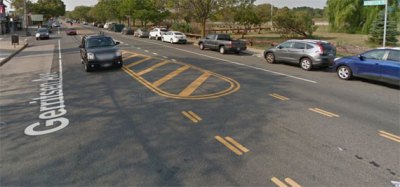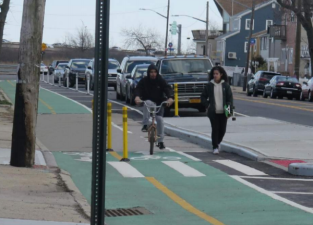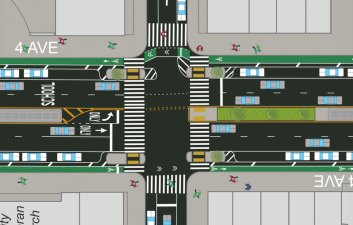No More Stalling: DOT Redesigns Gerritsen Ave After Teen Cyclist’s Death

DOT will install a two-way protected bike lane and other traffic-calming measures on Gerritsen Avenue, the street next to Marine Park in southern Brooklyn where a drunk driver killed a teenage cyclist this summer [PDF].
On the night of July 19, Thomas Groarke, 24, overtook another driver on the left and sped into the wide painted median on Gerritsen near Gotham Avenue, then fatally struck 17-year-old Sean Ryan, who was riding his bike southbound, the Daily News reported. Three other people were injured in the crash. Groarke’s blood alcohol level was found to be twice the legal limit.
Gerritsen Avenue is a wide street with a speeding problem and a history of traffic injuries and deaths. Since 2007, there have been four fatalities on the street, according to DOT, including three in the past two years. After the deaths of Joseph Ciresi and James Miro last fall, the Times looked at the street’s reputation as a drag strip.
The city has tinkered with the design of Gerritsen Avenue before. After a motorist severely injured 12-year-old cyclist Anthony Turturro in 2004 at the same intersection where Ryan was killed, the city implemented a four-lane-to-three-lane road diet with a painted median. In 2008 and 2009, the city floated concrete pedestrian islands and painted bike lanes for Gerritsen but backed off after local residents protested the changes. The only change implemented was to narrow the medians to make room for a “wide parking lane” (instead of painted bike lanes).

DOT’s new design finally narrows the motorway, adds the raised medians, and provides a bikeway that could have protected Anthony Turturro and Sean Ryan. A curbside two-way bike lane protected by parked cars and six new bus boarding islands will run along Marine Park on the east side of the street. Medians at nine intersections will get concrete pedestrian islands. And the city will add a signalized crossing at Channel Avenue by P.S. 277.
The day after Ryan was killed this summer, neighbors, including Turturro, marched down Gerritsen Avenue in his honor to demand that the city address speeding on the corridor. This time, DOT is not waiting for permission before taking action.
The redesign will be installed “in late October/early November,” according to a DOT spokesperson.



